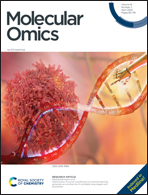Transcriptome profiling of hiPSC-derived LSECs with nanoCAGE†
Abstract
Liver Sinusoidal Endothelial Cells (LSECs) are an important component of the liver as they compose the microvasculature which allows the supply of oxygen, blood, and nutrients. However, maintenance of these cells in vitro remains challenging as they tend to rapidly lose some of their characteristics such as fenestration or as their immortalized counterparts present poor characteristics. In this work, human induced pluripotent stem cells (hiPSCs) have been differentiated toward an LSEC phenotype. After differentiation, the RNA quantification allowed demonstration of high expression of specific vascular markers (CD31, CD144, and STAB2). Immunostaining performed on the cells was found to be positive for both Stabilin-1 and Stabilin-2. Whole transcriptome analysis performed with the nanoCAGE method further confirmed the overall vascular commitment of the cells. The gene expression profile revealed the upregulation of the APLN, LYVE1, VWF, ESAM and ANGPT2 genes while VEGFA appeared to be downregulated. Analysis of promoter motif activities highlighted several transcription factors (TFs) of interest in LSECs (IRF2, ERG, MEIS2, SPI1, IRF7, WRNIP1, HIC2, NFIX_NFIB, BATF, and PATZ1). Based on this investigation, we compiled the regulatory network involving the relevant TFs, their target genes as well as their related signaling pathways. The proposed hiPSC-derived LSEC model and its regulatory network were then confirmed by comparing the experimental data to primary human LSEC reference datasets. Thus, the presented model appears as a promising tool to generate more complex in vitro liver multi-cellular tissues.



 Please wait while we load your content...
Please wait while we load your content...